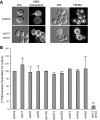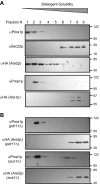ATP-binding cassette transporters and sterol O-acyltransferases interact at membrane microdomains to modulate sterol uptake and esterification
- PMID: 26220175
- PMCID: PMC4608909
- DOI: 10.1096/fj.14-264796
ATP-binding cassette transporters and sterol O-acyltransferases interact at membrane microdomains to modulate sterol uptake and esterification
Abstract
A key component of eukaryotic lipid homeostasis is the esterification of sterols with fatty acids by sterol O-acyltransferases (SOATs). The esterification reactions are allosterically activated by their sterol substrates, the majority of which accumulate at the plasma membrane. We demonstrate that in yeast, sterol transport from the plasma membrane to the site of esterification is associated with the physical interaction of the major SOAT, acyl-coenzyme A:cholesterol acyltransferase (ACAT)-related enzyme (Are)2p, with 2 plasma membrane ATP-binding cassette (ABC) transporters: Aus1p and Pdr11p. Are2p, Aus1p, and Pdr11p, unlike the minor acyltransferase, Are1p, colocalize to sterol and sphingolipid-enriched, detergent-resistant microdomains (DRMs). Deletion of either ABC transporter results in Are2p relocalization to detergent-soluble membrane domains and a significant decrease (53-36%) in esterification of exogenous sterol. Similarly, in murine tissues, the SOAT1/Acat1 enzyme and activity localize to DRMs. This subcellular localization is diminished upon deletion of murine ABC transporters, such as Abcg1, which itself is DRM associated. We propose that the close proximity of sterol esterification and transport proteins to each other combined with their residence in lipid-enriched membrane microdomains facilitates rapid, high-capacity sterol transport and esterification, obviating any requirement for soluble intermediary proteins.
Keywords: ABC transporter; cholesteryl ester; lipid droplet; sterol transport.
© FASEB.
Figures









Similar articles
-
ATP-binding cassette (ABC) transporters mediate nonvesicular, raft-modulated sterol movement from the plasma membrane to the endoplasmic reticulum.J Biol Chem. 2004 Oct 22;279(43):45226-34. doi: 10.1074/jbc.M407600200. Epub 2004 Aug 16. J Biol Chem. 2004. PMID: 15316012
-
Heme-regulated expression of two yeast acyl-CoA:sterol acyltransferases is involved in the specific response of sterol esterification to anaerobiosis.FEMS Microbiol Lett. 2002 Jan 2;206(1):121-5. doi: 10.1111/j.1574-6968.2002.tb10996.x. FEMS Microbiol Lett. 2002. PMID: 11786267
-
Sterol esterification in yeast: a two-gene process.Science. 1996 May 31;272(5266):1353-6. doi: 10.1126/science.272.5266.1353. Science. 1996. PMID: 8650549
-
Acyl-CoA:cholesterol acyltransferases (ACATs/SOATs): Enzymes with multiple sterols as substrates and as activators.J Steroid Biochem Mol Biol. 2015 Jul;151:102-7. doi: 10.1016/j.jsbmb.2014.09.008. Epub 2014 Sep 12. J Steroid Biochem Mol Biol. 2015. PMID: 25218443 Free PMC article. Review.
-
Molecular aspects of intracellular sterol esterification: the acyl coenzyme A: cholesterol acyltransferase reaction.Curr Opin Lipidol. 1997 Jun;8(3):167-73. doi: 10.1097/00041433-199706000-00007. Curr Opin Lipidol. 1997. PMID: 9211065 Review.
Cited by
-
Functional Analysis of Sterol O-Acyltransferase Involved in the Biosynthetic Pathway of Pachymic Acid in Wolfiporia cocos.Molecules. 2021 Dec 27;27(1):143. doi: 10.3390/molecules27010143. Molecules. 2021. PMID: 35011377 Free PMC article.
-
Pdr18 is involved in yeast response to acetic acid stress counteracting the decrease of plasma membrane ergosterol content and order.Sci Rep. 2018 May 18;8(1):7860. doi: 10.1038/s41598-018-26128-7. Sci Rep. 2018. PMID: 29777118 Free PMC article.
-
Erg25 Controls Host-Cholesterol Uptake Mediated by Aus1p-Associated Sterol-Rich Membrane Domains in Candida glabrata.Front Cell Dev Biol. 2022 Mar 24;10:820675. doi: 10.3389/fcell.2022.820675. eCollection 2022. Front Cell Dev Biol. 2022. PMID: 35399500 Free PMC article.
-
Exposure to dietary lipid leads to rapid production of cytosolic lipid droplets near the brush border membrane.Nutr Metab (Lond). 2016 Jul 28;13:48. doi: 10.1186/s12986-016-0107-9. eCollection 2016. Nutr Metab (Lond). 2016. PMID: 27478484 Free PMC article.
-
Regulation of Ergosterol Biosynthesis in Saccharomyces cerevisiae.Genes (Basel). 2020 Jul 15;11(7):795. doi: 10.3390/genes11070795. Genes (Basel). 2020. PMID: 32679672 Free PMC article. Review.
References
-
- Yang H., Bard M., Bruner D. A., Gleeson A., Deckelbaum R. J., Aljinovic G., Pohl T. M., Rothstein R., Sturley S. L. (1996) Sterol esterification in yeast: a two-gene process. Science 272, 1353–1356 - PubMed
-
- Yang H., Cromley D., Wang H., Billheimer J. T., Sturley S. L. (1997) Functional expression of a cDNA to human acyl-coenzyme A:cholesterol acyltransferase in yeast. Species-dependent substrate specificity and inhibitor sensitivity. J. Biol. Chem. 272, 3980–3985 - PubMed
-
- Oelkers P., Behari A., Cromley D., Billheimer J. T., Sturley S. L. (1998) Characterization of two human genes encoding acyl coenzyme A:cholesterol acyltransferase-related enzymes. J. Biol. Chem. 273, 26765–26771 - PubMed
-
- Cheng D., Chang C. C., Qu X., Chang T. Y. (1995) Activation of acyl-coenzyme A:cholesterol acyltransferase by cholesterol or by oxysterol in a cell-free system. J. Biol. Chem. 270, 685–695 - PubMed
Publication types
MeSH terms
Substances
Grants and funding
LinkOut - more resources
Full Text Sources
Other Literature Sources
Molecular Biology Databases
Miscellaneous

